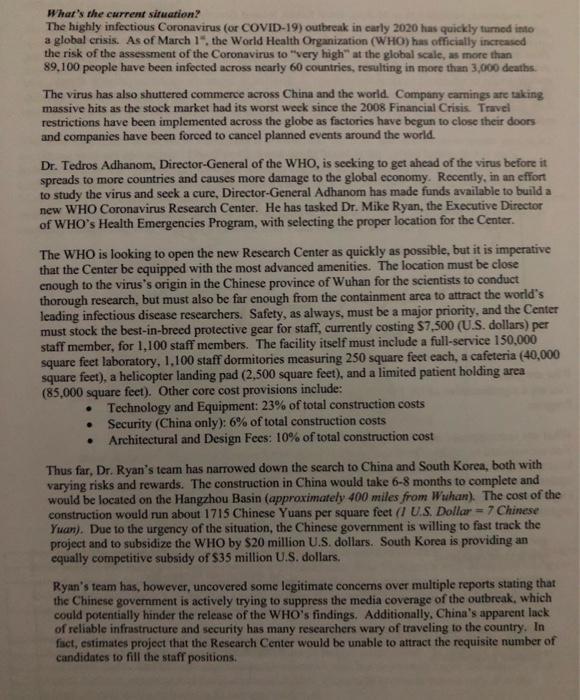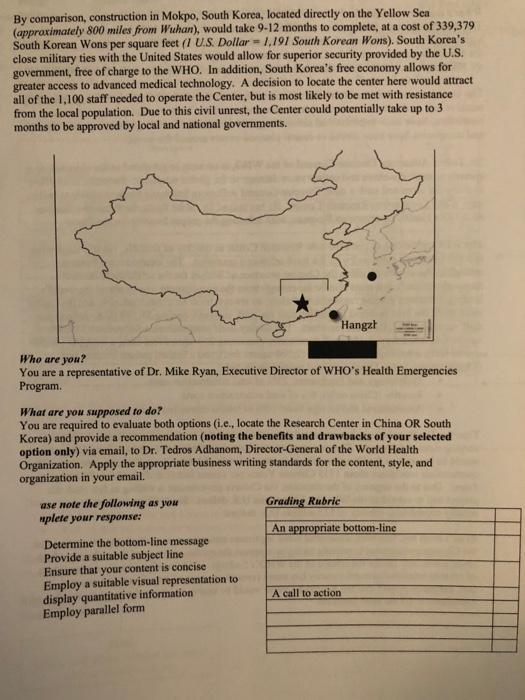

What's the current situation? The highly infectious Coronavirus (or COVID-19) outbreak in carly 2020 has quickly turned into a global crisis. As of March 14, the World Health Organization (WHO) has officially increased the risk of the assessment of the Coronavirus to "very high at the global scale, as more than 89.100 people have been infected across nearly 60 countries, resulting in more than 3,000 deaths. The virus has also shuttered commerce across China and the world. Company earnings are taking massive hits as the stock market had its worst week since the 2008 Financial Crisis Travel restrictions have been implemented across the globe as factories have begun to close their doors and companies have been forced to cancel planned events around the world. Dr. Tedros Adhanom, Director-General of the WHO, is seeking to get ahead of the virus before it spreads to more countries and causes more damage to the global economy. Recently, in an effort to study the virus and seek a cure, Director-General Adhanom has made funds available to build a new WHO Coronavirus Research Center. He has tasked Dr. Mike Ryan, the Executive Director of WHO's Health Emergencies Program, with selecting the proper location for the Center. The WHO is looking to open the new Research Center as quickly as possible, but it is imperative that the Center be equipped with the most advanced amenities. The location must be close enough to the virus's origin in the Chinese province of Wuhan for the scientists to conduct thorough research, but must also be far enough from the containment area to attract the world's leading infectious disease researchers. Safety, as always, must be a major priority, and the Center must stock the best-in-breed protective gear for staff, currently costing $7,500 (U.S. dollars) per staff member, for 1.100 staff members. The facility itself must include a full-service 150,000 square feet laboratory, 1.100 staff dormitories measuring 250 square feet each, a cafeteria (40,000 square feet), a helicopter landing pad (2,500 square feet), and a limited patient holding area (85,000 square feet). Other core cost provisions include: Technology and Equipment: 23% of total construction costs Security (China only): 6% of total construction costs Architectural and Design Fees: 10% of total construction cost Thus far, Dr. Ryan's team has narrowed down the search to China and South Korea, both with varying risks and rewards. The construction in China would take 6-8 months to complete and would be located on the Hangzhou Basin (approximately 400 miles from Wuhan). The cost of the construction would run about 1715 Chinese Yuans per square feet (1 U.S. Dollar = 7 Chinese Yuan). Due to the urgency of the situation, the Chinese government is willing to fast track the project and to subsidize the WHO by $20 million U.S. dollars. South Korea is providing an equally competitive subsidy of $35 million U.S. dollars. Ryan's team has, however, uncovered some legitimate concerns over multiple reports stating that the Chinese government is actively trying to suppress the media coverage of the outbreak, which could potentially hinder the release of the WHO's findings. Additionally, China's apparent lack of reliable infrastructure and security has many researchers wary of traveling to the country. In fact, estimates project that the Research Center would be unable to attract the requisite number of candidates to fill the staff positions. By comparison, construction in Mokpo, South Korea, located directly on the Yellow Sea (approximately 800 miles from Wuhan), would take 9-12 months to complete, at a cost of 339,379 South Korean Wons per square feet (I U.S. Dollar = 1,191 South Korean Wons). South Korea's close military ties with the United States would allow for superior security provided by the U.S. government, free of charge to the WHO. In addition, South Korea's free economy allows for greater access to advanced medical technology. A decision to locate the center here would attract all of the 1,100 staff needed to operate the Center, but is most likely to be met with resistance from the local population. Due to this civil unrest, the Center could potentially take up to 3 months to be approved by local and national governments. Hangat Who are you? You are a representative of Dr. Mike Ryan, Executive Director of WHO's Health Emergencies Program. What are you supposed to do? You are required to evaluate both options (i.c., locate the Research Center in China OR South Korea) and provide a recommendation (noting the benefits and drawbacks of your selected option only) via email, to Dr. Tedros Adhanom, Director-General of the World Health Organization. Apply the appropriate business writing standards for the content, style, and organization in your email. ase note the following as you Grading Rubric mplete your response: An appropriate bottom-line Determine the bottom-line message Provide a suitable subject line Ensure that your content is concise Employ a suitable visual representation to display quantitative information A call to action Employ parallel form What's the current situation? The highly infectious Coronavirus (or COVID-19) outbreak in carly 2020 has quickly turned into a global crisis. As of March 14, the World Health Organization (WHO) has officially increased the risk of the assessment of the Coronavirus to "very high at the global scale, as more than 89.100 people have been infected across nearly 60 countries, resulting in more than 3,000 deaths. The virus has also shuttered commerce across China and the world. Company earnings are taking massive hits as the stock market had its worst week since the 2008 Financial Crisis Travel restrictions have been implemented across the globe as factories have begun to close their doors and companies have been forced to cancel planned events around the world. Dr. Tedros Adhanom, Director-General of the WHO, is seeking to get ahead of the virus before it spreads to more countries and causes more damage to the global economy. Recently, in an effort to study the virus and seek a cure, Director-General Adhanom has made funds available to build a new WHO Coronavirus Research Center. He has tasked Dr. Mike Ryan, the Executive Director of WHO's Health Emergencies Program, with selecting the proper location for the Center. The WHO is looking to open the new Research Center as quickly as possible, but it is imperative that the Center be equipped with the most advanced amenities. The location must be close enough to the virus's origin in the Chinese province of Wuhan for the scientists to conduct thorough research, but must also be far enough from the containment area to attract the world's leading infectious disease researchers. Safety, as always, must be a major priority, and the Center must stock the best-in-breed protective gear for staff, currently costing $7,500 (U.S. dollars) per staff member, for 1.100 staff members. The facility itself must include a full-service 150,000 square feet laboratory, 1.100 staff dormitories measuring 250 square feet each, a cafeteria (40,000 square feet), a helicopter landing pad (2,500 square feet), and a limited patient holding area (85,000 square feet). Other core cost provisions include: Technology and Equipment: 23% of total construction costs Security (China only): 6% of total construction costs Architectural and Design Fees: 10% of total construction cost Thus far, Dr. Ryan's team has narrowed down the search to China and South Korea, both with varying risks and rewards. The construction in China would take 6-8 months to complete and would be located on the Hangzhou Basin (approximately 400 miles from Wuhan). The cost of the construction would run about 1715 Chinese Yuans per square feet (1 U.S. Dollar = 7 Chinese Yuan). Due to the urgency of the situation, the Chinese government is willing to fast track the project and to subsidize the WHO by $20 million U.S. dollars. South Korea is providing an equally competitive subsidy of $35 million U.S. dollars. Ryan's team has, however, uncovered some legitimate concerns over multiple reports stating that the Chinese government is actively trying to suppress the media coverage of the outbreak, which could potentially hinder the release of the WHO's findings. Additionally, China's apparent lack of reliable infrastructure and security has many researchers wary of traveling to the country. In fact, estimates project that the Research Center would be unable to attract the requisite number of candidates to fill the staff positions. By comparison, construction in Mokpo, South Korea, located directly on the Yellow Sea (approximately 800 miles from Wuhan), would take 9-12 months to complete, at a cost of 339,379 South Korean Wons per square feet (I U.S. Dollar = 1,191 South Korean Wons). South Korea's close military ties with the United States would allow for superior security provided by the U.S. government, free of charge to the WHO. In addition, South Korea's free economy allows for greater access to advanced medical technology. A decision to locate the center here would attract all of the 1,100 staff needed to operate the Center, but is most likely to be met with resistance from the local population. Due to this civil unrest, the Center could potentially take up to 3 months to be approved by local and national governments. Hangat Who are you? You are a representative of Dr. Mike Ryan, Executive Director of WHO's Health Emergencies Program. What are you supposed to do? You are required to evaluate both options (i.c., locate the Research Center in China OR South Korea) and provide a recommendation (noting the benefits and drawbacks of your selected option only) via email, to Dr. Tedros Adhanom, Director-General of the World Health Organization. Apply the appropriate business writing standards for the content, style, and organization in your email. ase note the following as you Grading Rubric mplete your response: An appropriate bottom-line Determine the bottom-line message Provide a suitable subject line Ensure that your content is concise Employ a suitable visual representation to display quantitative information A call to action Employ parallel form








